Scientific name Angraecum Rank Genus | Alliance Angraecum Higher classification Orchids | |
 | ||
Lower classifications Angraecum sesquipedale, Angraecum eburneum, Angraecum didieri, Angraecum leonis, Angraecum distichum | ||
Plant of the month angraecum eichlerianum
The genus Angraecum, abbreviated as Angcm in horticultural trade, common name Angrek (Indonesian and Malay) or Comet Orchid, contains about 220 species.
Contents
- Plant of the month angraecum eichlerianum
- Repotting monster orchid angraecum veitchii
- Description
- Distribution
- Angraecum Conservation
- Growing Angraecums
- Hybrids
- References
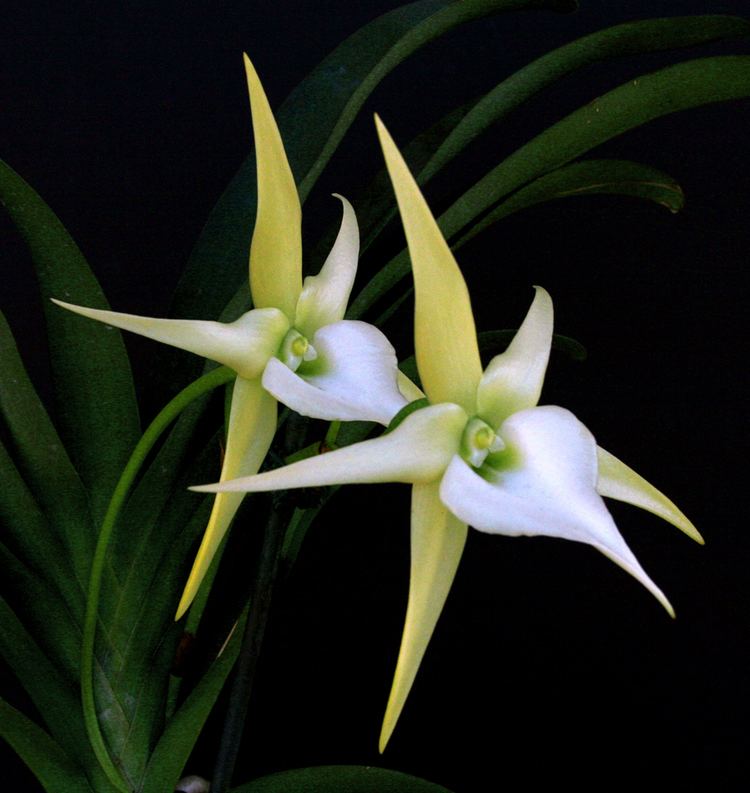
Repotting monster orchid angraecum veitchii
Description
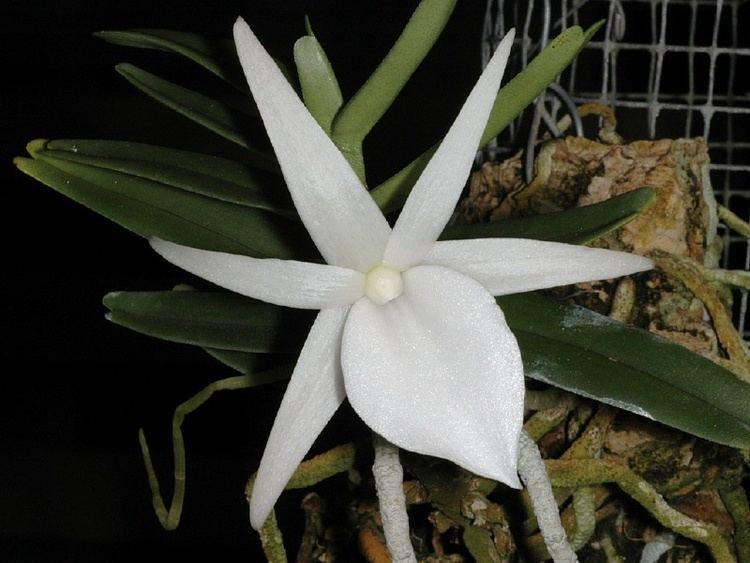
They are quite varied vegetatively and florally and are adapted to dry tropical woodland habitat and have quite fleshy leaves as a consequence. Most are epiphytes, but a few are lithophytes.
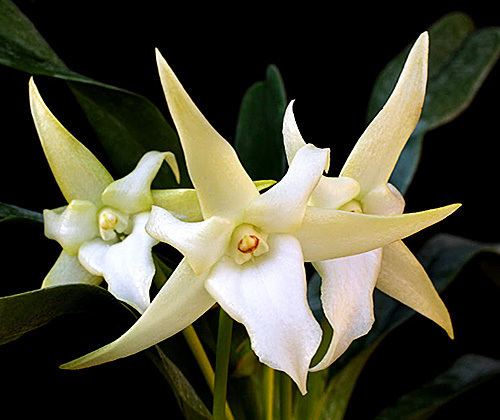
The long-lasting flowers are racemose and grow from the leaf axils. They are mostly white, but a few are yellow, green or ochre. They all have a long spur at the back of the labellum (lip).
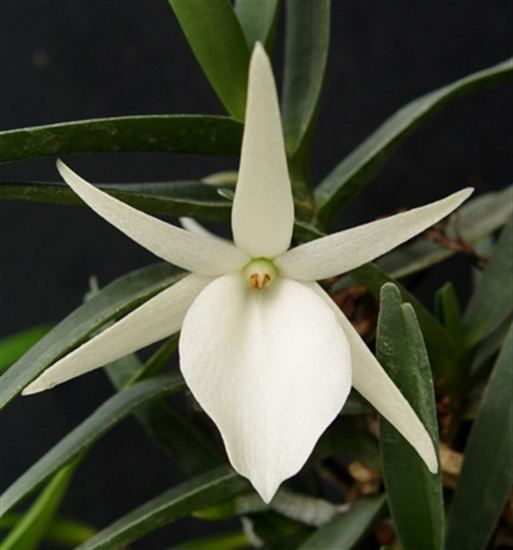
In the case of Angraecum sesquipedale, a species from Madagascar, on observing the 30 cm spur in the lip, Charles Darwin made the hypothesis that, since the nectar was at the bottom of the spur, a pollinator must exist with a tongue at least that long. Otherwise the orchid could never be pollinated. At the time, he was not believed. However, in 1903, the predicted pollinator was discovered, a hawk moth then named Xanthopan morganii praedicta ("praedicta" meaning "the predicted one"). It has an appropriately long proboscis. The specific name sesquipedale means "one foot and a half", referring to the length of the spur. This is a perfect example of mutual dependence of an orchid and a specific pollinator.
Distribution
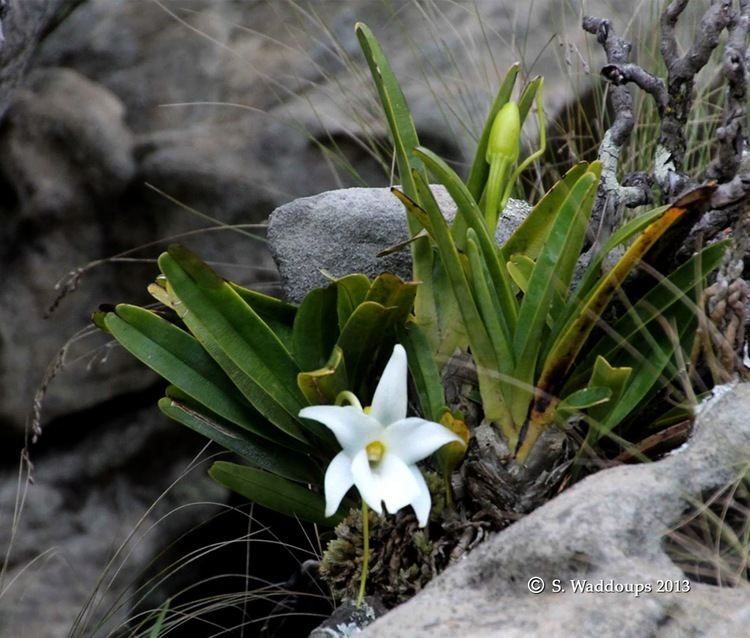
Tropical Africa and Madagascar contain the majority of the genus with one outlier found on Sri Lanka, and three species once thought to belong to the genus in Japan and the Philippines. But these orchids can also be found on the Comoros, the Seychelles, and the Mascarenes. They occur between sea level and 2,000m in humid regions.
Angraecum Conservation
Many species of Angraecum orchid are considered to be at risk of extinction in the wild and are protected from international trade under CITES. The genus Angraecum is listed as one of the top conservation priorities by the International Union for Conservation of Nature and Natural Resources (IUCN) Orchid Specialist Group. Many of the species, such as Angraecum sororium, are endemic to Madagascar and are threatened from over collecting, loss of hawkmoth pollinators, habitat fragmentation, and fire.
Growing Angraecums
Like all other orchids it is best to water in the mornings to avoid fungal rot due to overnight dampness. Feeding as per other orchids and similar light conditions: in humid and hot regions (sub tropical) feed fortnightly during growing season (Summer) with a certified orchid fertiliser following directions on packet, weaker solutions are also okay if you're worried. In summer water weekly or more depending on situation. Angraecums flower best when in a lighter position. Keep out of direct sunlight as this can damage (and eventually kill) the plant. Most Angraecums will have their leaves for a number of years so any sun burn spots are ugly for a significant period and also may expose your plant to disease. In indirect sunlight the Angraecums will reward you with blooms and attractive growth.
Angraecum Veitchii: a very rewarding orchid. In indirect light and watered/fed regularly this plant will produce blooms annually (usually in Late Winter to Spring - for Australia this occurs in August). The flowers last a while if kept in a sheltered position and their strong heady fragrance is delightful. They only release their perfume at night. Flowers are large (4 – 9 cm across), waxy, white to greenish cream in colour and borne on stems of seven to ten depending on the faithfulness of your fertilising, watering, and indirect light provision. The leaves are large, thick straps that alternately fan out from a central (monopodal) stem. Pups (keikis) form at the base of the stem and can either be divided from the parent plant once they have at least three roots of their own or alternatively, left on the plant these will make a stunning specimen as when mature will produce blooms with the parent plant - many award winning angraecum veitchiis are grown as such. In the right conditions these orchids are healthy and require little attention. As they are epiphytes the potting mixture should be loose and free draining. Prolific roots are formed from the base and also amongst the lower half of the foliage. These can be troublesome when moving the plant. Once your angraecum is big it is best to pot it in a heavy terracotta pot or place a brick in the bottom of the pot in order to ensure the plant does not get top heavy and risk snapping when blown over in the wind, especially since they flower during the windier times of the year. When watering a good soaking with a hose or watering-can is best (not just a misting from a spray gun) as this helps to flush away any salts from fertilisers that may be present in the potting mixture and also thoroughly wets the plant. Make sure the roots halfway up the stem get a soaking too, not just the potted roots.
